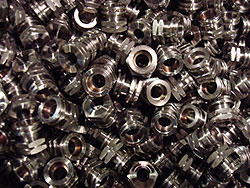Klincher Locknuts – How It Works
How the Klincher Locknut Works
The Klincher Locknut has a free spinning nut to reduce the stress concentration found in the first three threads of a nut and bolt. This allows more wrench torque to be applied to the Klincher Locknut without plastic deformation to the bolt. The nut spins freely on the bolt down to the workpiece. After proper torque has been applied to the Klincher Locknut, the integrated washer compresses, causing the threaded section inside the washer to move in and lock radially and axially on the bolt. When the threads absorb a maximum load, they elongate a few thousandths of an inch, allowing the majority of the load to move up into the main body of the nut.

Klincher Locknuts are Reusable
Unlike many lock nuts, the Klincher Locknut is reusable as long as it stays within the specified torque values, the threads are not damaged and the overall length stays within the dimension. When these criteria are met, the Klincher Locknut can be reused and retains its locking qualities. Tests have shown that the Klincher Locknut was reusable after as many as 30 times.
Klincher Locknut Independent Studies
Photoelastic studies at a major US university have shown an equitable distribution of stress over the entire Klincher Locknut, versus a severe stress concentration in the first few threads of typical prevailing torque nuts. This unique stress pattern found in the Klincher Locknut effectively lowers the strain on the bolt, allowing it to perform better and for a longer period, including repeated uses. Note that these studies were done on the standard Klincher Locknuts, not the custom, modified Build-to-Print versions used in some industries.
Klincher Locknuts Available in Multiple Sizes
Klincher Locknuts are available in the following standard sizes. Custom Build-to-Print versions with modified dimensions, tolerances and/or threading can also be manufactured (such as for the aviation and aerospace industries).
- # 4, # 6, # 8, # 10, 1/4″, 5/16″, 3/8″, 7/16″, 1/2″
- Maximum size is 1.25″ diameter in either fine or coarse threads.
Klincher Locknuts Applications
There is no other product like the Klincher Locknut, which is why many jet engine, aircraft and aerospace companies, as well as the oil & gas, military and defense, and other demanding industries have continued to use some version of them since the concept was introduced in 1943. For protecting and preserving bolts, studs, axle shafts, and more, the Klincher Locknut has no equal. When high vibration, tensile strength, corrosion and temperature are factors, companies rely on Klincher Locknuts. The Klincher Locknut’s unique design, even distribution of stress and loads, and ability to be reused, make it the perfect lock nut for demanding applications.
Fill out our Inquiry Form for a Fast Response to your questions!
Dual Machine manufactures both standard Klincher Locknuts, as well as Build-to-Print versions for the aviation and aerospace industry, where different dimensions, tolerances and/or threading is required. In these cases, Dual Machine manufactures exactly what you specify for your specific application. Klincher Locknuts are commonly used in the following applications:

- Aerospace / Aviation
- Turbine Engines
- Automotive Turbochargers
- Military Applications
- High Temperature Applications
- High Vibration Applications
- Ship Building Applications
- Oil & Gas Applications

Klincher Locknuts – Performance Over the Years!
Contact us today to learn more about Klincher Locknuts and see how they can help you improve your product, process or application. Call 317-923-4786 or complete the form on our Contact Us page.
Fill out our Inquiry Form for a Fast Response to your questions!

